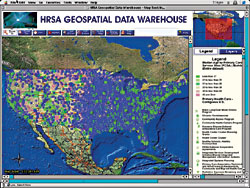Vital Signs
Research group puts primary care resources on the map
A new national database, developed by DMS's Center for the Evaluative Clinical Sciences and Virginia Commonwealth University, is quickly becoming a heavily used tool for improving the delivery of primary care. Called the Primary Care Service Area (PCSA) Project, it is the first comprehensive national database of primary-care physicians— the generalist physicians who are patients' first point of contact with the health-care system.

|
|
Thousands of data elements can be placed on PCSA maps like this one. |
The project has opened "a new era in primary-care planning," says DMS faculty member David Goodman, M.D., the project's principal investigator. It provides information about primary- care clinicians and populations within small standardized areas called PCSAs.
Defined: A PCSA (a term that Goodman and his colleagues pronounce "PIK-suh") is a small, defined geographic area with its own supply of physicians, midlevel providers, rural health centers, community clinics, and hospitals. Each PCSA's population base can be categorized by numerous social and economic indicators— such as race, gender, age, and median household income— as well as by Medicare utilization statistics—such as visit rates for primary care, preventive care, and ob-gyn care.
Health-systems researchers and policy analysts can download data tables containing 1,000 to 2,000 variables on any PCSA.
Members of the public, too, can log on to the database and view maps of PCSAs—zooming in and even adding features such as roads, county boundaries, or rivers. Clicking on a region brings up information tables, so it's possible to compare PCSAs in terms of physician supply. The PCSA database is accessible at http://datawarehouse.hrsa.gov.
The federal Health Resources and Service Administration (HRSA) is using the PCSA data in various ways for primary-care planning. For example, the agency is studying how PCSAs can be incorporated into new federal rules for defining healthprofession shortage areas as well as medically underserved areas. HRSA plans to publish a proposal for the new rules in 2004.
Major coup: "We would quite frankly consider that a major coup," says Goodman, "because the current system of defining health-profession shortage areas doesn't really create a level playing field. States can create areas that appear to have a greater shortage, leaving . . . less aggressive state agencies at a comparative disadvantage."
PCSAs, however, are "a uniform methodology for the whole country—they offer a standardized way of looking at relative shortage or inadequacy."
HRSA is also using data from the PCSA Project to prioritize shortage areas for a federal initiative to expand community health clinics. With PCSAs, it is possible to see how close, in terms of driving time, an area of low primary-care supply is to an area of ample supply. In addition, HRSA is using PCSAs to study the need for school-based health centers as well as the special needs of homeless and publichousing populations.
States are using PCSA data as well. David Bott, Ph.D., a research associate at Dartmouth's Center for the Evaluative Clinical Sciences and a public investigator with the New Hampshire State Board of Health, is comparing PCSA's Medicare data with state data to better define areas that need improved primary care for poor and elderly populations.
Impact: The PCSA Project is also having an impact on children's health. Goodman is working with the American Association of Pediatrics to develop a pediatric PCSA database, including dynamic mapping capabilities and tables (see http://www.aap.org/mapping/). It will primarily be used as a child health advocacy tool, says Goodman, but also as a way to better identify areas of low physician supply or to examine population characteristics such as bilingualism or ethnicity.
Finally, he adds, "primarycare physicians seeking jobs— this is a tool for them."
Matthew C. Wiencke
